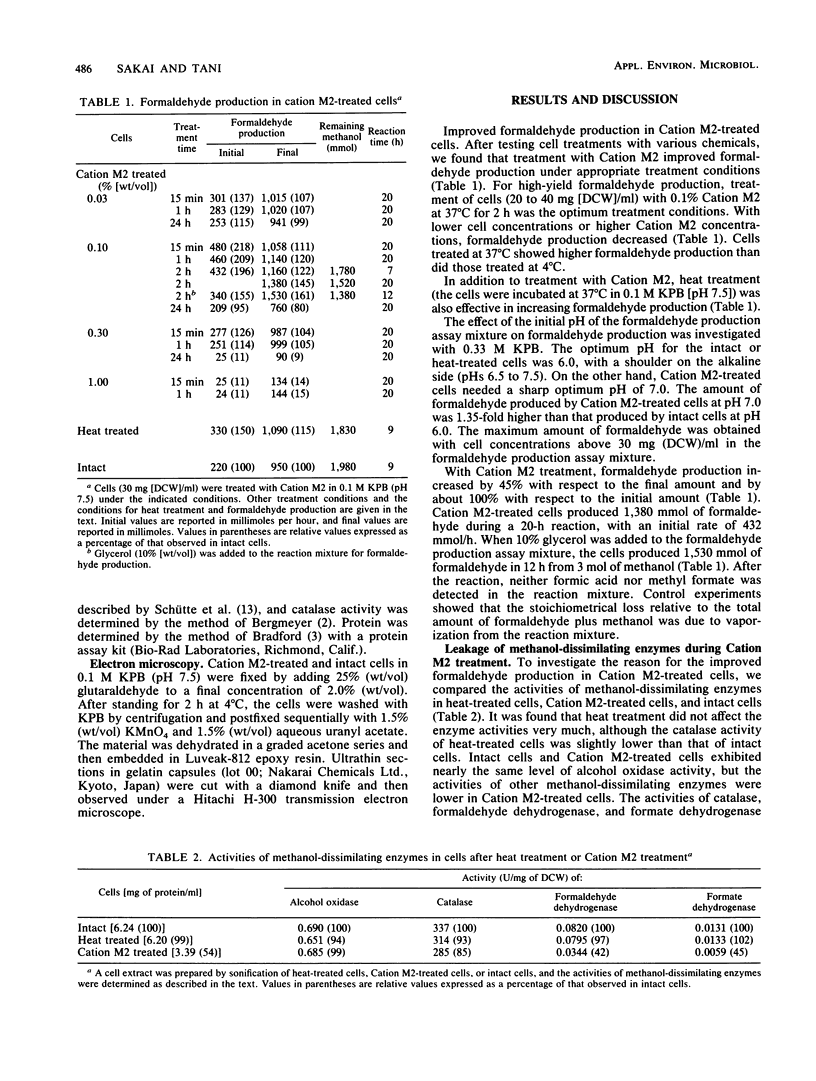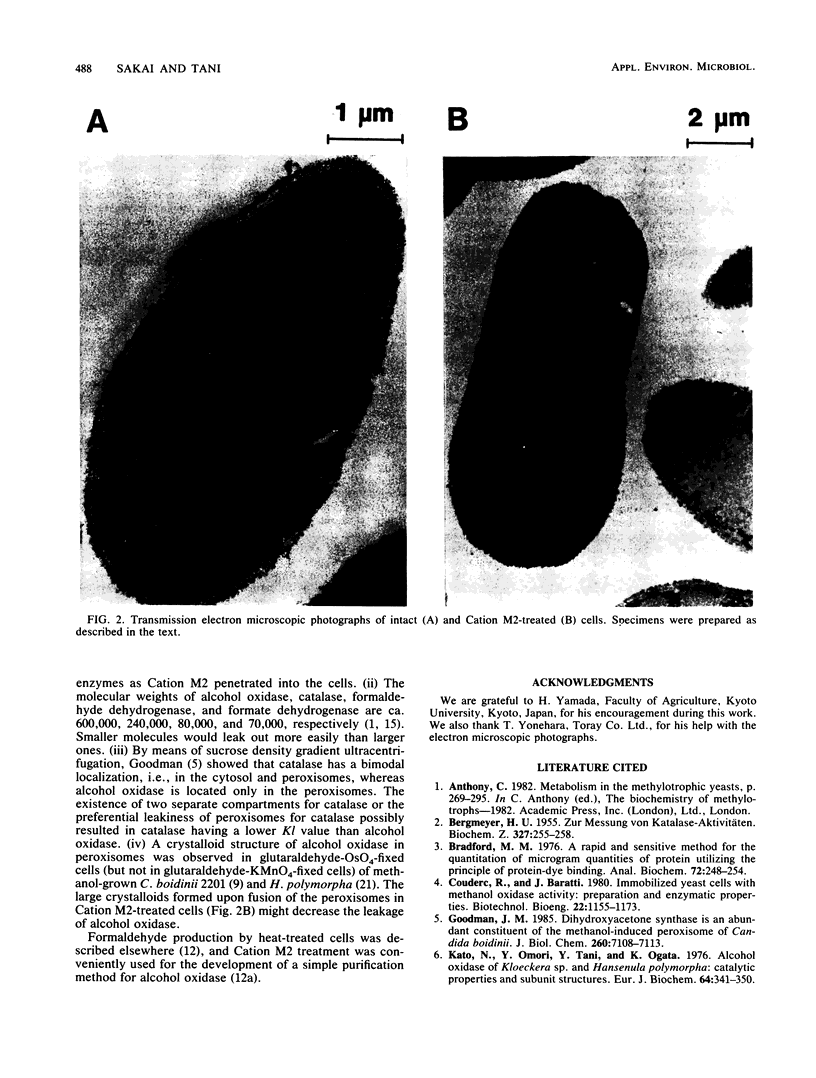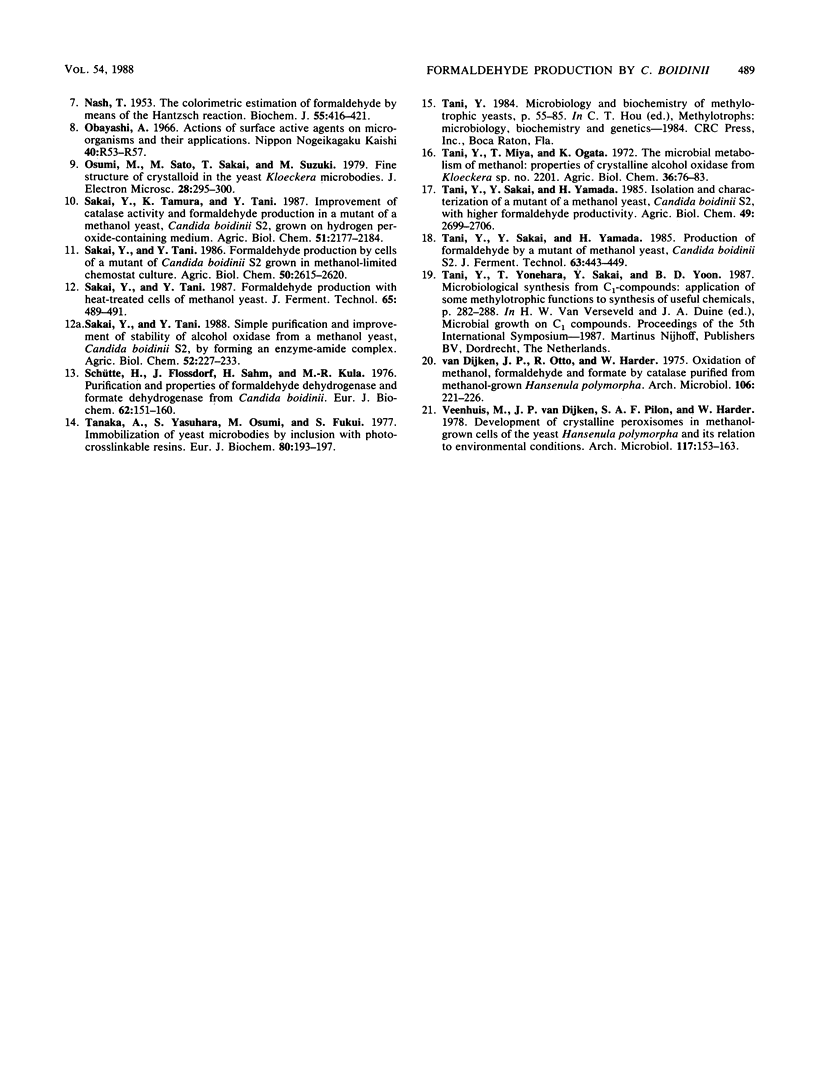Abstract
Treatment of cells of a methanol yeast, Candida boidinii, with the cationic detergent cetyldimethylbenzyl-ammonium chloride (Cation M2) improved the production of formaldehyde. Formaldehyde production was improved twofold with respect to the initial amount of formaldehyde and 1.61-fold with respect to the final amount of formaldehyde after a 12-h reaction under optimized detergent treatment conditions. The treatment caused formaldehyde and formate dehydrogenases to leak out of the cells more rapidly than catalase, but there was no leakage of alcohol oxidase. The improvement in formaldehyde production was considered to be due to the increased permeability of yeast cell membranes and to lower activities of formaldehyde and formate dehydrogenases in Cation M2-treated cells than in intact cells. Changes in the ultrastructure of the cells were observed upon Cation M2 treatment. Several developed peroxisomes were observed in intact cells. After Cation M2 treatment, the cells were obviously damaged, and several peroxisomes seemed to have fused with each other.
Full text
PDF




Images in this article
Selected References
These references are in PubMed. This may not be the complete list of references from this article.
- BERGMEYER H. U. Zur Messung von Katalase-Aktivitäten. Biochem Z. 1955;327(4):255–258. [PubMed] [Google Scholar]
- Bradford M. M. A rapid and sensitive method for the quantitation of microgram quantities of protein utilizing the principle of protein-dye binding. Anal Biochem. 1976 May 7;72:248–254. doi: 10.1006/abio.1976.9999. [DOI] [PubMed] [Google Scholar]
- Goodman J. M. Dihydroxyacetone synthase is an abundant constituent of the methanol-induced peroxisome of Candida boidinii. J Biol Chem. 1985 Jun 10;260(11):7108–7113. [PubMed] [Google Scholar]
- Kato N., Omori Y., Tani Y., Ogata K. Alcohol oxidases of Kloeckera sp. and Hansenula polymorpha. Catalytic properties and subunit structures. Eur J Biochem. 1976 May 1;64(2):341–350. doi: 10.1111/j.1432-1033.1976.tb10307.x. [DOI] [PubMed] [Google Scholar]
- NASH T. The colorimetric estimation of formaldehyde by means of the Hantzsch reaction. Biochem J. 1953 Oct;55(3):416–421. doi: 10.1042/bj0550416. [DOI] [PMC free article] [PubMed] [Google Scholar]
- Schüte H., Flossdorf J., Sahm H., Kula M. R. Purification and properties of formaldehyde dehydrogenase and formate dehydrogenase from Candida boidinii. Eur J Biochem. 1976 Feb 2;62(1):151–160. doi: 10.1111/j.1432-1033.1976.tb10108.x. [DOI] [PubMed] [Google Scholar]
- Tanaka A., Yasuhara S., Osumi M., Fukui S. Immobilization of yeast microbodies by inclusion with photo-crosslinkable resins. Eur J Biochem. 1977 Oct 17;80(1):193–197. doi: 10.1111/j.1432-1033.1977.tb11871.x. [DOI] [PubMed] [Google Scholar]
- Valiere-Vialeix J. P., Lehner M. A., Couderc J. L. Effets inhabituels de l'épinéphrine. A propos de 4 observations. Bull Soc Ophtalmol Fr. 1980 Dec;80(12):1153–1155. [PubMed] [Google Scholar]
- Veenhuis M., van Dijken J. P., Pilon S. A., Harder W. Development of crystalline peroxisomes in methanol-grown cells of the yeast Hansenula polymorpha and its relation to environmental conditions. Arch Microbiol. 1978 May 30;117(2):153–163. doi: 10.1007/BF00402303. [DOI] [PubMed] [Google Scholar]
- van Dijken J. P., Otto R., Harder W. Oxidation of methanol, formaldehyde and formate by catalase purified from methanol-grown Hansenula polymorpha. Arch Microbiol. 1975 Dec 31;106(3):221–226. doi: 10.1007/BF00446527. [DOI] [PubMed] [Google Scholar]



